MARIANI’S
Virtual
Gourmet
December 21,
2014
NEWSLETTER

❖❖❖
IN THIS ISSUE
STAYING PUT IN MILAN
By John Mariani
NEW YORK CORNER
ANDAZ and ALDO SOHM WINE BAR
By John Mariani
NOTES FROM THE WINE CELLAR
WINES FOR THE HOLIDAYS
By John Mariani
❖❖❖
STAYING PUT IN MILAN
By John Mariani

Il Duomo (photo by John Mariani)
Though Milan is usually a
tick down from Rome, Venice and Florence on
tourists’ list of must-see Italian cities, it is
in fact one of the grandest and possibly the most
civilized city in Italy. I shall write about
Milan’s rich history, elegant culture and
wonderful trattorias at another time, so for the
moment let me concentrate on where to stay in this
wealthy Lombardian city, which now has a passel of
the finest deluxe properties in Italy.
In fact, what once passed for five-star
hotels in Italy were never in a class with those in
Paris, London, or Zurich. Twenty years ago, the best
Italian hotels clung to the idea that frayed
antiques and dim post-war lighting held an alluring
charm for visitors.
But the expansion of international business
and of high-end hotel chains like The Four Seasons,
Ritz-Carlton, Dorchester Group, and others in Europe
have forced Italian hotels radically to upgrade
their premises, restaurants and service.
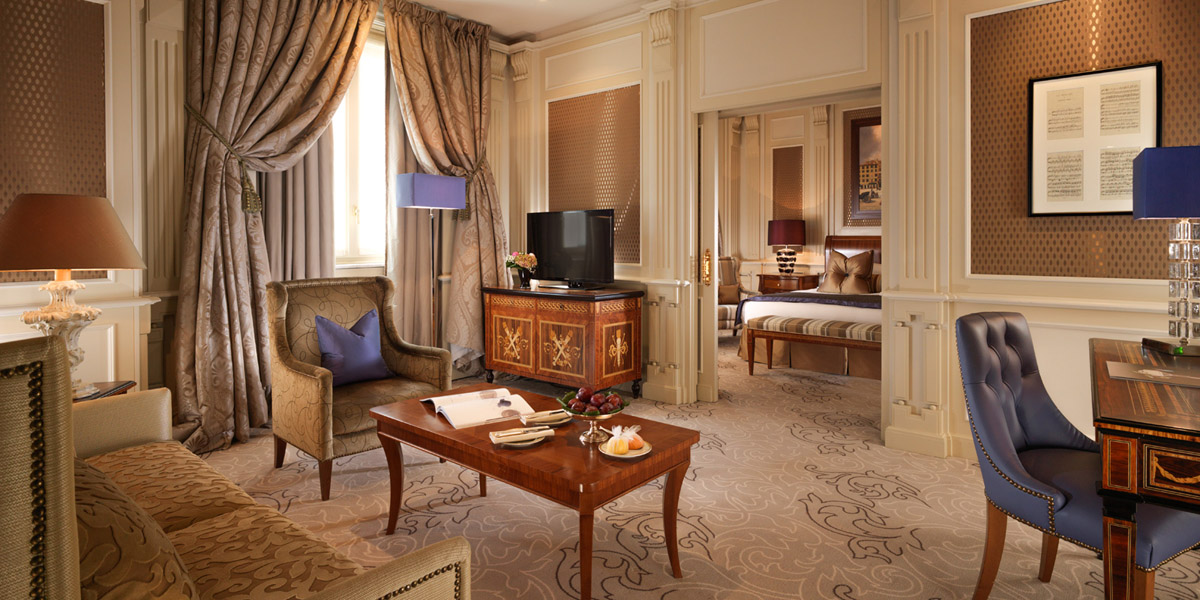 It was in
Milan that the opening of The Four Seasons back in
1993 in a 15th
century convent (nuns not included) changed
everything. Its contemporary Milanese décor,
American-size bathrooms, pool, air-conditioning, and
the cuisine at its Il Teatro were of such high
quality and the hotel’s success so immediate that
older, well established hotels had to modernize
quickly and new ones to follow had to be at least as
good.
It was in
Milan that the opening of The Four Seasons back in
1993 in a 15th
century convent (nuns not included) changed
everything. Its contemporary Milanese décor,
American-size bathrooms, pool, air-conditioning, and
the cuisine at its Il Teatro were of such high
quality and the hotel’s success so immediate that
older, well established hotels had to modernize
quickly and new ones to follow had to be at least as
good.
HOTEL
PRINCIPE DI SAVOIA
Piazza della Repubblica, 17
39 02 62304007
http://www.hotelprincipedisavoia.com>
One
of the grandest of the old hotels in Milan is the Principe di
Savoia on
the broad Piazza della Repubblica. I hadn’t
been back in years, so I was enchanted to see how a
hotel that had for decades lived on its historic
reputation had been transformed in such a careful
way as to maintain its original grandeur while
adding 21st century
glamour to the public and private rooms. Restored
and brightened by designer Thierry Despond, its
lobby and hallways were polished and softly lighted,
its rooms, like the Ambassador Suite in the photo
above, not just freshened but wholly reconceived by
marrying classic good taste with every amenity.
There’s a gorgeously seductive swimming pool, a
state-of-the-art spa and fitness center and a
beautiful tea room.
There is also complimentary 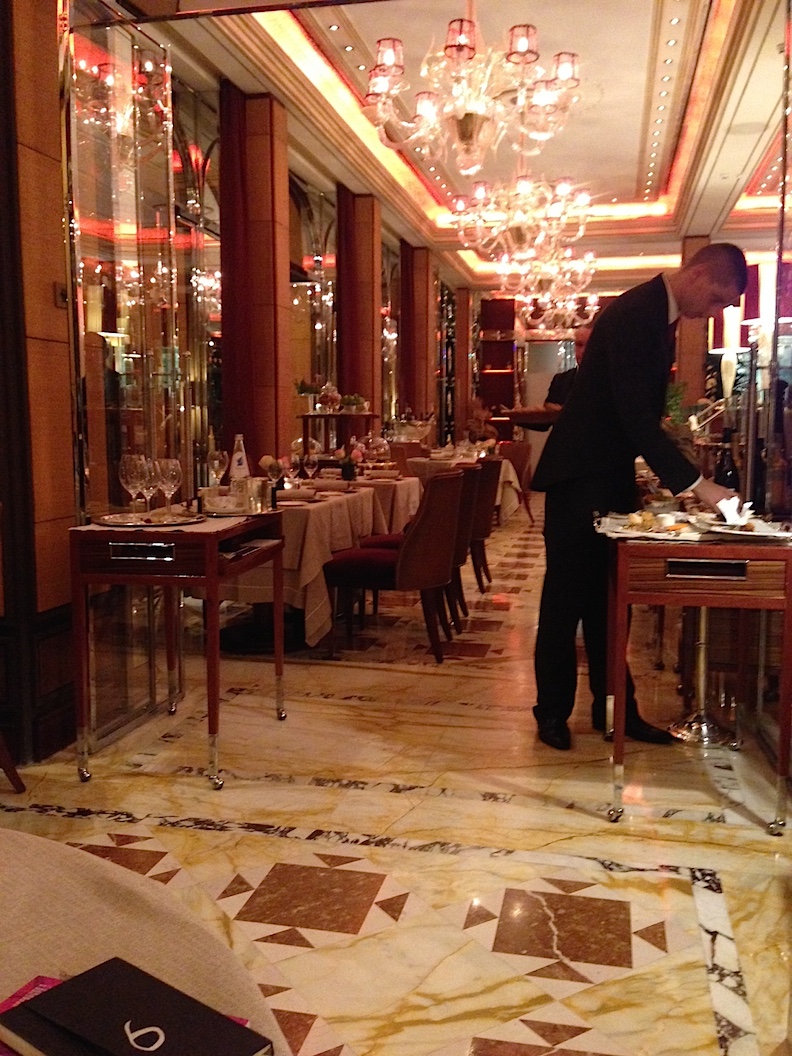 limo service
to the city’s center. (Breakfast is not included in
the room price.)
limo service
to the city’s center. (Breakfast is not included in
the room price.)
The main dining room, Acanto (right), is now
one of the most beautiful restaurants in Milan, with
gleaming Murano glass chandeliers and expanses of
mahogany and glass, so that everything, from
stemware to silverware, glitters under the lights
and the pink roses on every table glow. The kitchen
is overseen by Chef Fabrizio Cadei, whose €85 menu
(white truffles extra) is remarkable for five
courses, beginning with a croquette of liquefied
Parmigiano dotted with 25-year-old balsamico. They
serve a pinzimonio—an
old tradition—of raw carrots, celery and radishes
with an anchovy dipping sauce. Next came
a profiterole of zucchini and hazelnut crumble
bathed in a Parmigiano fondue and a flan made with
zbibbo wine.
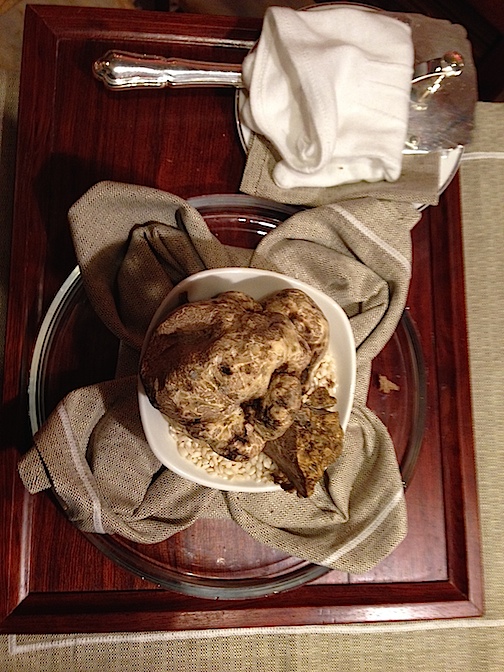 The aroma of a white
truffle the size of a bocce ball (left) wafted
across the room, and the captain was generous in
shaving the tuber over tender rice from Grumolo
delle Abbadesse, as well as over housemade tagliarini pasta. Tournedos
of veal cheeks with a gratin of
pumpkin, Parmigiano foam and balsamico made for a
perfect winter’s dish, as did maialino—baby
pig—in three different cuts, with baked apples. A
frozen soufflé ended off the dessert, with a coup de
grace of gooseberries,
chocolates and petit-fours.
The aroma of a white
truffle the size of a bocce ball (left) wafted
across the room, and the captain was generous in
shaving the tuber over tender rice from Grumolo
delle Abbadesse, as well as over housemade tagliarini pasta. Tournedos
of veal cheeks with a gratin of
pumpkin, Parmigiano foam and balsamico made for a
perfect winter’s dish, as did maialino—baby
pig—in three different cuts, with baked apples. A
frozen soufflé ended off the dessert, with a coup de
grace of gooseberries,
chocolates and petit-fours.
For the holidays, Acanto is offering a six-course
dinner at €95 euros, with a glass of sparkling
wine; seven course Christmas day lunch at €145;
and eight-course New Year’s Eve dinner at €365
(tax and service included).
PARK HYATT MILAN
Via
Tommaso
Grossi 1
39 02 8821 1234
I also had occasion to return to
(though not to stay at) the Park Hyatt
Milan, which opened ten years ago near the
Financial District, and whose VUN ristorante
(below) has
been recently relocated and done over in a
chiaroscuro of light and shadow, in muted colors of
gray, red, and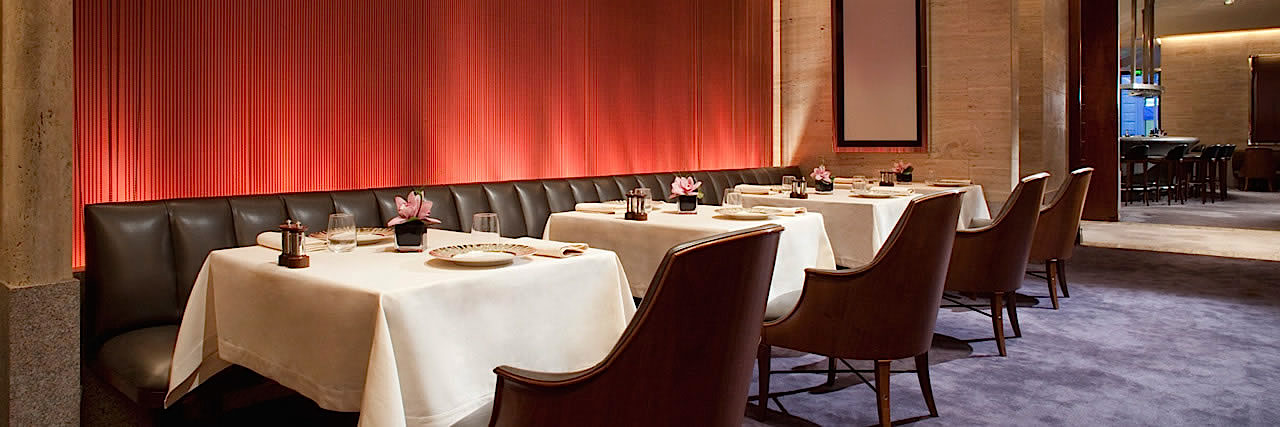 rich
travertine marble, with widely separated tables,
superb linens and glassware, and one of the city’s
deepest wine lists—45 pages of well-selected gems,
overseen by the
affable Sommelier Valentina Benedetti.
rich
travertine marble, with widely separated tables,
superb linens and glassware, and one of the city’s
deepest wine lists—45 pages of well-selected gems,
overseen by the
affable Sommelier Valentina Benedetti.
Naples-born Chef Andrea Aprea’s motto is, “My
contemporary cuisine looks to the future, but never
forgets its origins,” amply backed by modernist
techniques and traditional flavors, both Lombardian
and Neapolitan, best appreciated through his tasting
menus. Thus,
you find a deliciously simple pasta like paccheri
with buffalo ricotta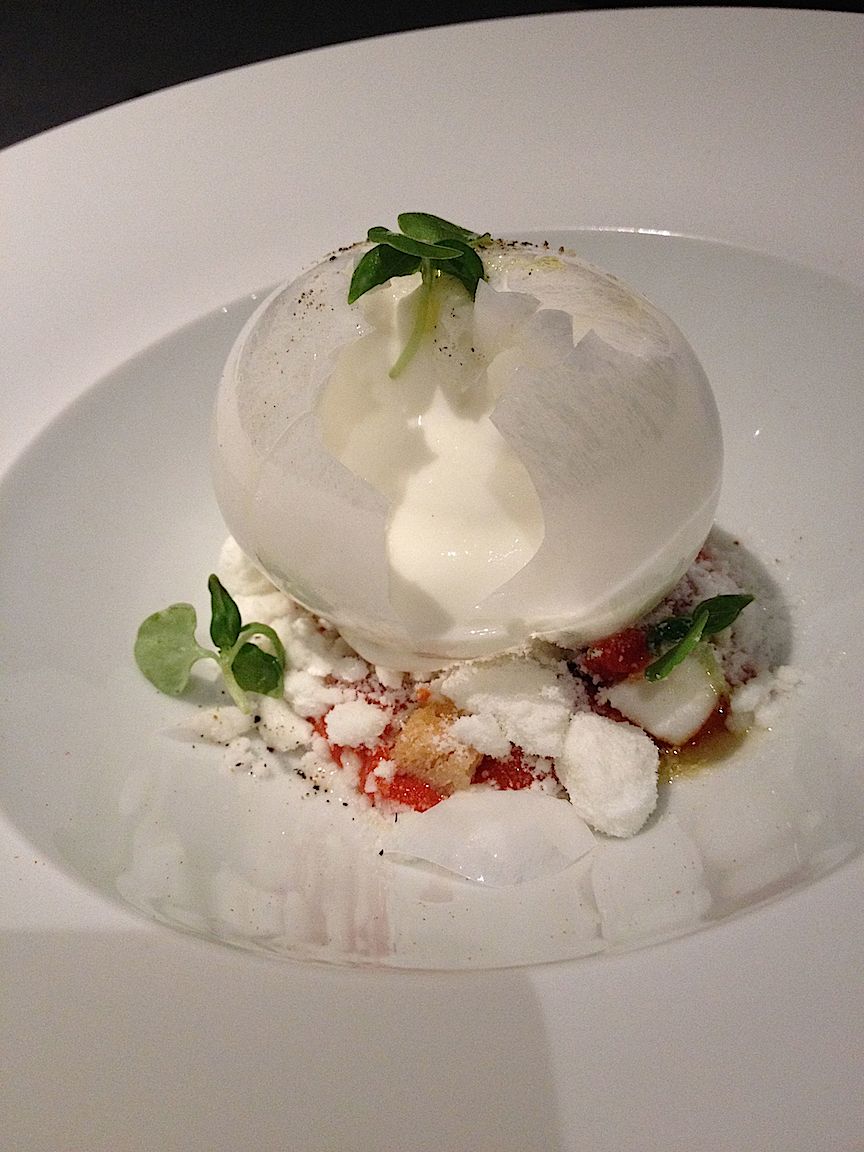 and ragù, while
whole wheat linguine is entangled with Venus clams,
turnip tops and candied lemon.
and ragù, while
whole wheat linguine is entangled with Venus clams,
turnip tops and candied lemon.
But Aprea’s signature dish is an
extraordinary tour de force called “Caprese Sweet
and Salty” (left),
his reinterpretation of a classic
mozzarella-tomato-and-basil insalata di
Caprese.
“Mainly, I wanted to reconstruct the
spherical shape of buffalo mozzarella cheese
using isomalt sugar,” says Aprea, “a similar
technique to blowing Murano glass. On the plate
there is a tomato coulis, basil pesto emulsion,
anchovies, croutons, buffalo mozzarella and
mozzarella snow; the ball is filled with a buffalo
mozzarella foam and on top basil cress.”
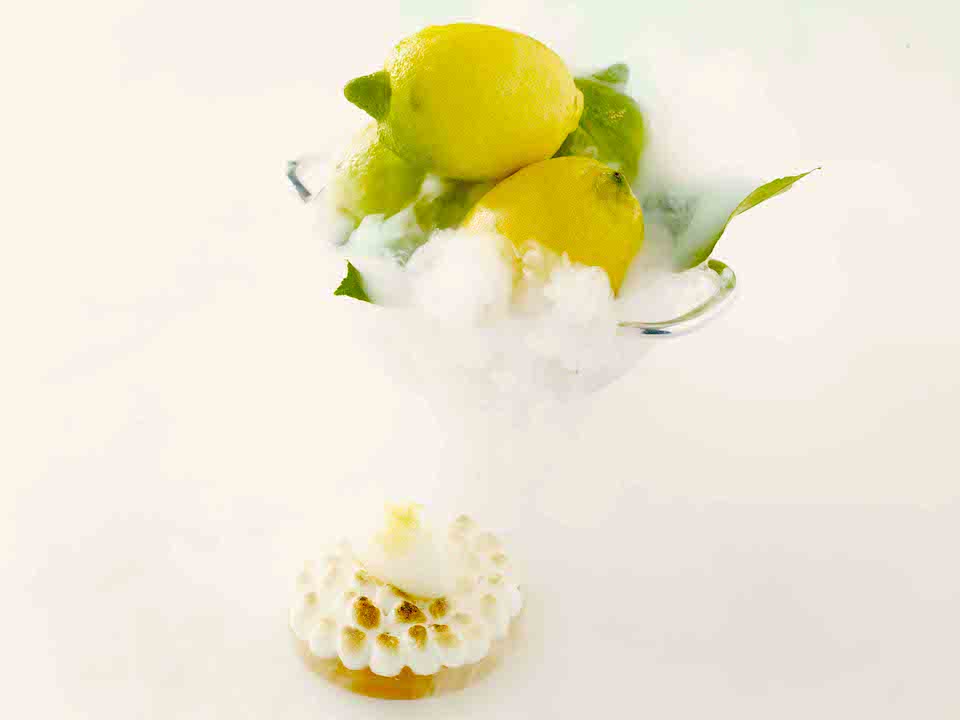 A single
seared scallop is decorated with pumpkin, salted
meringue and wild mushrooms; potatoes are wrapped in
foil and lavished with goat’s cheese, red chicory,
and pepper; quail
comes with grape, foie gras and cool yogurt.
A single
seared scallop is decorated with pumpkin, salted
meringue and wild mushrooms; potatoes are wrapped in
foil and lavished with goat’s cheese, red chicory,
and pepper; quail
comes with grape, foie gras and cool yogurt.
Monkfish is crafted
as ossobuco,
with parsnips, licorice, saffron and orange, while
beautifully cooked, moist turbot shares the plate
with marinated vegetables, puffed brown rice and
mustard. There
is even a dish using dry ice, but not on the
ingredients, only to add drama to the table: it’s
called “lemon sensation” (left) made from lemon gelée, cream
custard, shortbread, candied lemon, sorbet, meringue
and zest. The table is set with a basket of lemons
on dry ice, onto which an infusion of lemons is
poured, sending boiling fumes scented with citrus
into the air, so that all five senses are
tantalized.
The tasting menus at
VUN is €115-€150; a la carte, first courses
€30-€45; pastas €25-30; main courses €42-€45.
39 02 625-62555
palazzoparigi.com
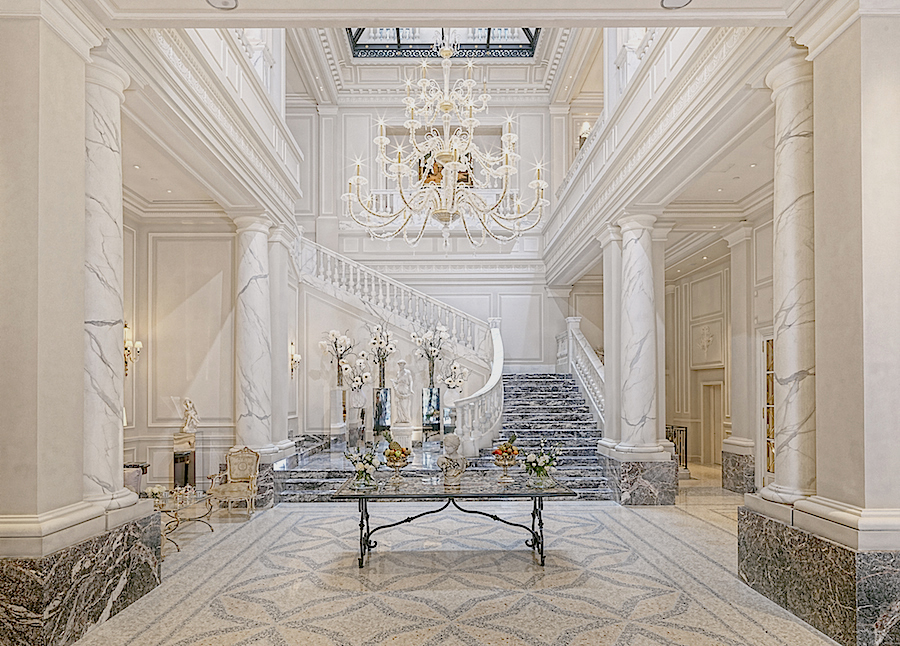 The newest
and certainly the most posh five-star hotel to open
in Milan is the Palazzo Parigi
Hotel & Grand Spa, which does in fact sit
on the site of a 16th century
palazzo but whose every square inch is brand new,
done over by owner/architect Paola Giambelli and
interior designer Pierre-Yves Rochon to marry
Milanese and Parisian elements, starting
with one of the most magnificent entrance
halls I’ve ever seen.
Bright white marble in great profusion
surrounds a grand staircase; pink Baveno marble
columns evoke the Scala Theatre, and the wood
accents of the skylighted Caffé Parigi and the
Lounge Bar are inspired by the drawing-room in Villa
Reale.
The newest
and certainly the most posh five-star hotel to open
in Milan is the Palazzo Parigi
Hotel & Grand Spa, which does in fact sit
on the site of a 16th century
palazzo but whose every square inch is brand new,
done over by owner/architect Paola Giambelli and
interior designer Pierre-Yves Rochon to marry
Milanese and Parisian elements, starting
with one of the most magnificent entrance
halls I’ve ever seen.
Bright white marble in great profusion
surrounds a grand staircase; pink Baveno marble
columns evoke the Scala Theatre, and the wood
accents of the skylighted Caffé Parigi and the
Lounge Bar are inspired by the drawing-room in Villa
Reale.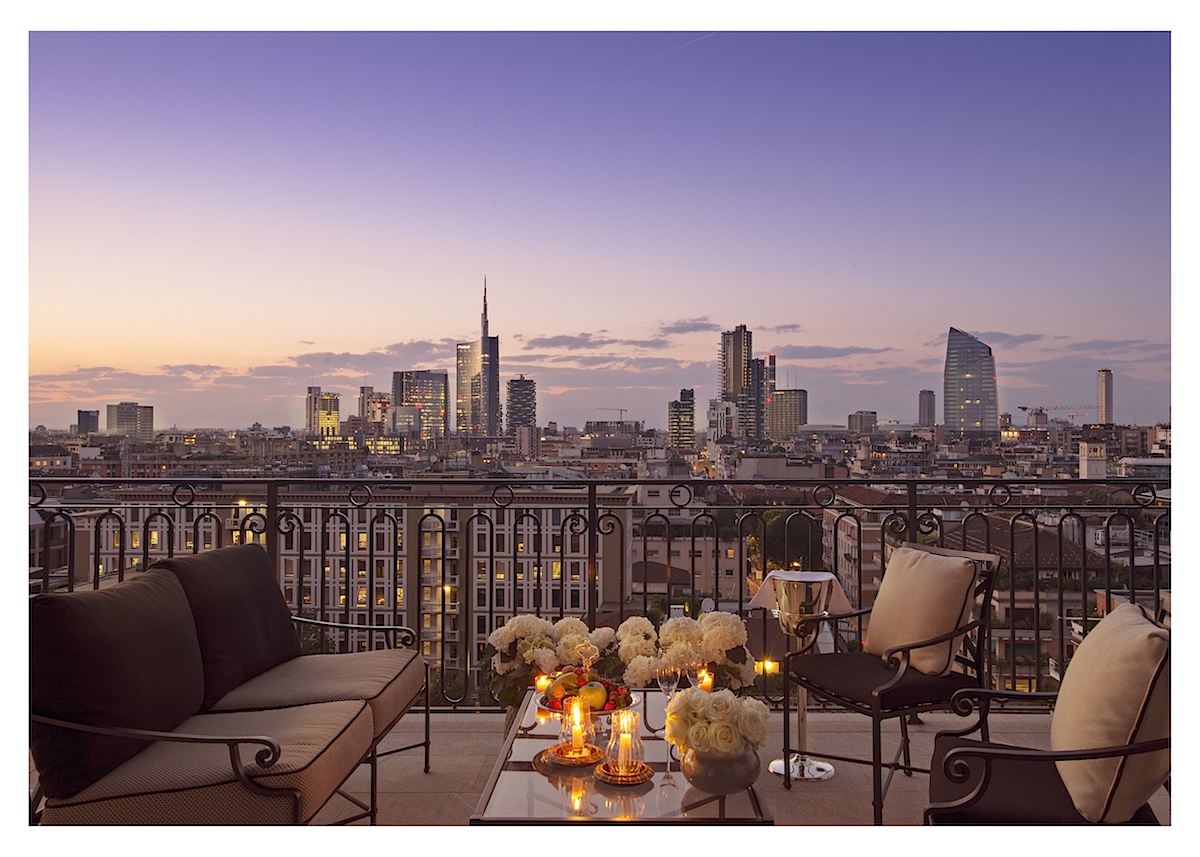
The 65 rooms and 33 suites, all
different in décor, have an aristocratic
spaciousness, with large terraces and tall windows
open to Milan’s soft sunlight (right). The
Ballroom is said to be the largest in the city.
The Palazzo
Parigi is also seriously committed to reducing the
building’s environmental impact by using modern raw
materials, recycling throughout, solar panels, and
more.
The day I ate at the Palazzo Parigi, the main
dining room (below),
with its tables surrounding a center platform where
the chef adds
his final touches to each dish, was closed. But
Manager Davide Galluccio was kind enough to have the
kitchen treat me to items from the dinner menu at
the sleek adjacent Caffé overlooking the garden.
The meal
was a marvelous array of inventive, delicate dishes,
from antipasti
like a Piedmontese beef tartare and porcini
salad to a creamy foie gras terrine with caramelized
figs and brioche.
Around the holidays no pasta is more welcome
in Italy than pumpkin tortello with buffalo milk cheese and
baby onions braised in wine. Paccheri pasta came in a
scorpionfish soup with caramelized tomato.
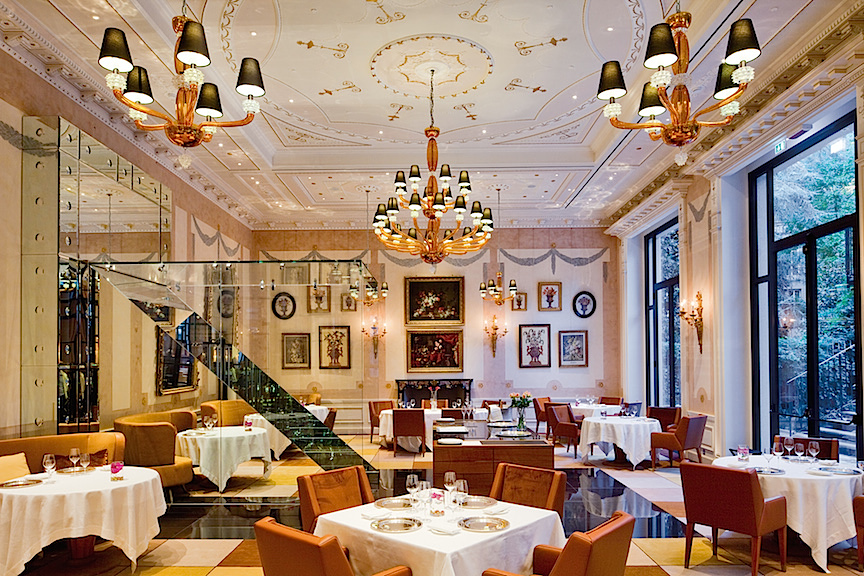 Milan may be
landlocked, but its chefs willingly pay for the best
seafood, as shown in a dish of blue Breton
lobster with crispy Parma ham and baccalà cooked
with
corn, onions and zucchini flowers. An Asian
influence is evident in a crisp duck breast with
green tomatoes and tender bok choy.
Milan may be
landlocked, but its chefs willingly pay for the best
seafood, as shown in a dish of blue Breton
lobster with crispy Parma ham and baccalà cooked
with
corn, onions and zucchini flowers. An Asian
influence is evident in a crisp duck breast with
green tomatoes and tender bok choy.
Sommelier Matteo Ghiringhelli,
27, loves nothing more than to match them with your
meal.
For
Christmas Eve, the restaurant will serve an
8-course dinner with three wines at €120 per
person (€45 for children)
HOTEL MILANO SCALA
Via dell'Orso, 8
39 02 87096812
hotelmilanoscala.it
For those who
wish to stay at something less than the five-star
level, I recommend the four-year-old, four-star Hotel Milano
Scala, which proves how smaller boutique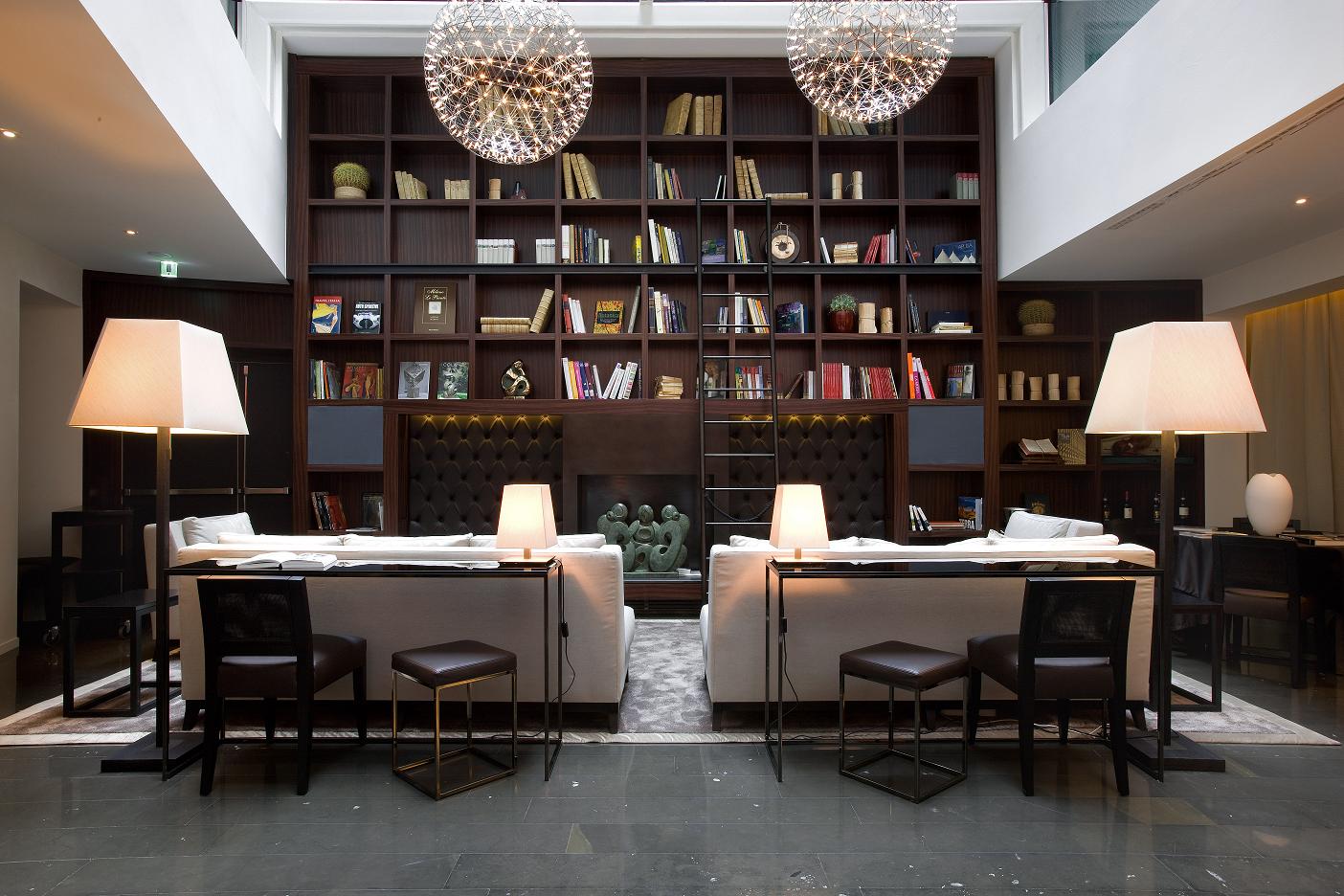 hotels have also upped
their game with a higher level of style and service
from a decade ago.
With 52 rooms and 10 suites, many with
terraces, the Milano Scala, which is part of the
Preferred Hotel Group, offers amenities and
conveniences requisite to business
travelers--complimentary WiFi, pillow menus, online
international newspapers, and live soft music in the
comfortable Foyer Library (right) downstairs—all making the
nice, quiet small hotel on a narrow secluded street
a very convenient, moderately priced place to stay
in the Brera district, near the Galleria Vittorio
Emmanuele II, La Scala, and the fashion district.
hotels have also upped
their game with a higher level of style and service
from a decade ago.
With 52 rooms and 10 suites, many with
terraces, the Milano Scala, which is part of the
Preferred Hotel Group, offers amenities and
conveniences requisite to business
travelers--complimentary WiFi, pillow menus, online
international newspapers, and live soft music in the
comfortable Foyer Library (right) downstairs—all making the
nice, quiet small hotel on a narrow secluded street
a very convenient, moderately priced place to stay
in the Brera district, near the Galleria Vittorio
Emmanuele II, La Scala, and the fashion district.
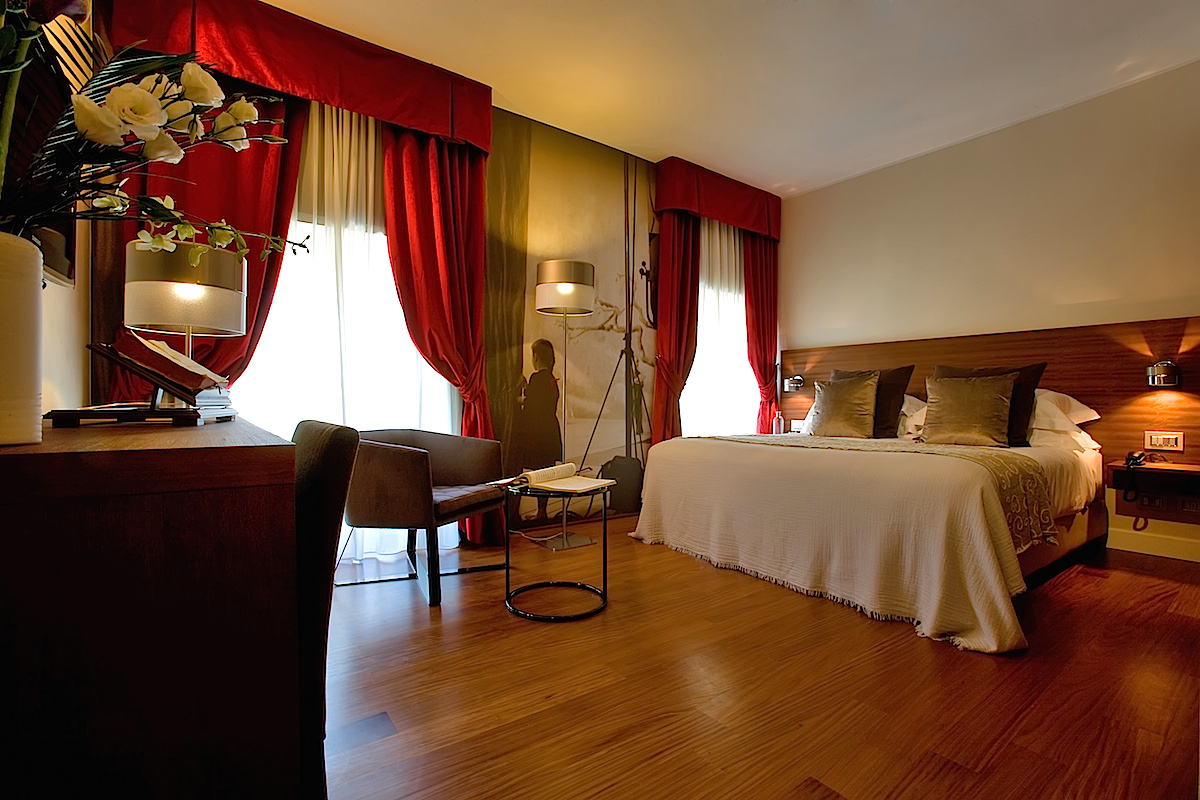 Indeed,
music is the stylistic theme in the décor, so walls
and rooms (left)
are done with motifs of musical clefs and historic
scenes of the La Scala opera.
Indeed,
music is the stylistic theme in the décor, so walls
and rooms (left)
are done with motifs of musical clefs and historic
scenes of the La Scala opera.
I also found the young staff and
concierge extremely helpful and wholly affable. The
restaurant was going through a transition when I
stayed there, so I cannot report on the food, but
the complimentary buffet breakfast in the morning
was as lavish as to be found in higher class hotels.
Currently Hotel
Milano Scala offers holiday promotions, with rooms
for two people for three nights total of $739, $845, $1092,
and $140
❖❖❖
Small Is Beautiful: Two for Midtown
By John Mariani
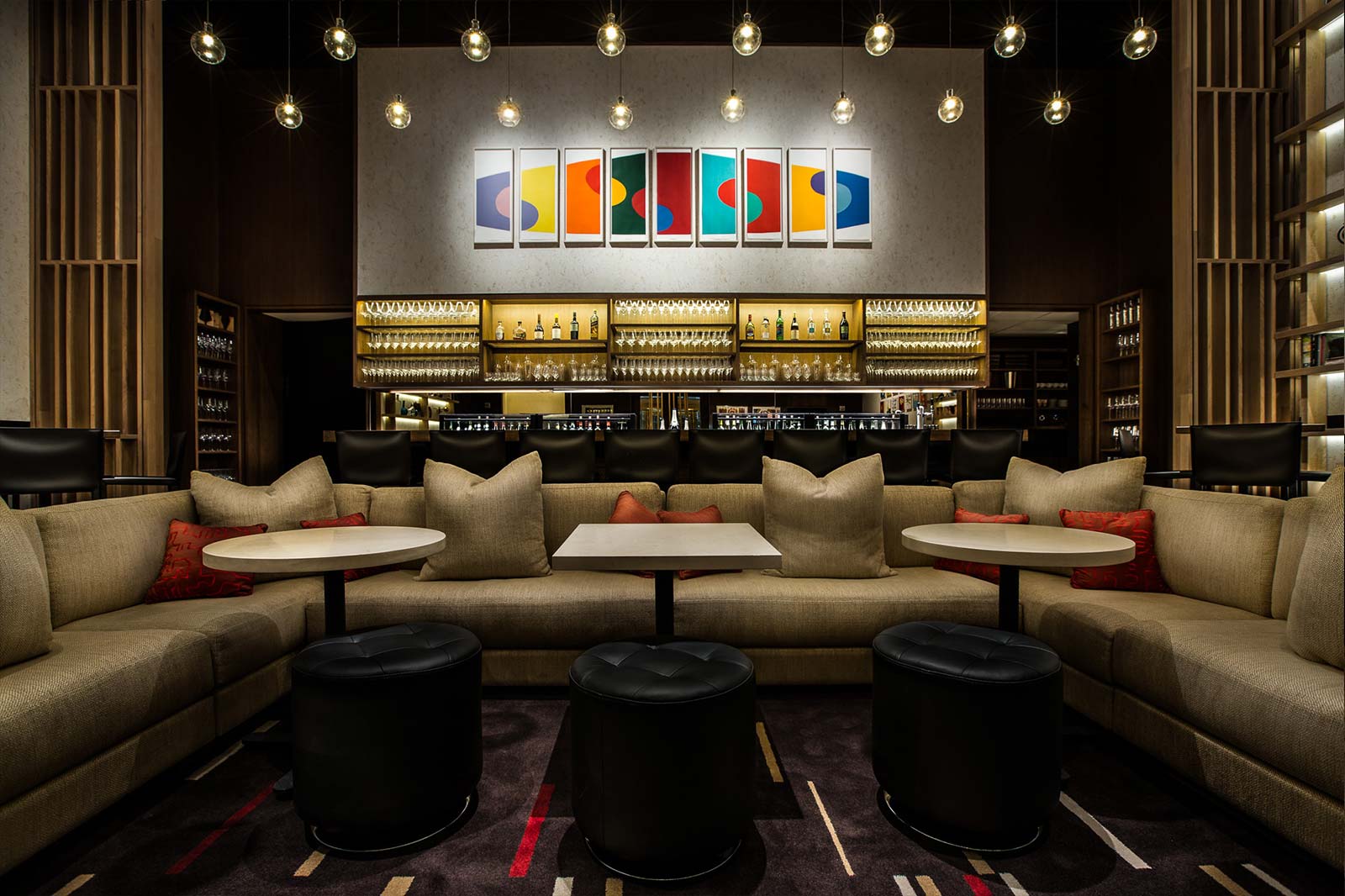
“I wanted this to be a
real European wine bar,” says Aldo Sohm (below), best
known—until now—as sommelier at NYC’s illustrious
French seafood restaurant Le Bernardin. “I didn’t
want to just serve a few wines by the glass and
some sausage and cheese. I wanted very good food and
an elegant but friendly atmosphere.”
From the looks of the crowd at
his new namesake wine bar he’s achieved what he
and his partner, Eric Ripert, chef-owner of Le
Bernardin, set out to do at the four-month-old
establishment, right across the way from Le
Bernardin in what was once the downstairs bar of
the posh Italian restaurant Palio. I
was certainly not the first to ask Mr. Sohm what
happened to the room’s spectacular and very
beautiful Sandro Chia murals of the Palio race in
Siena, Italy; everybody who remembers them does.
The murals were removed by the building owner for
restoration work, but it appears they will never
return to what is now Aldo Sohm Wine Bar.
Thus, while the place lacks a
masterpiece of modern Italian art, its décor, with
its counters and living room-like couches, sports
enough cartoon colors and graphic artwork to be
engagingly modern, with enough swank to imply that
this is not a place to knock back a couple of
brewskies or to watch a game while wearing a
Knicks jersey.
So far, the crowd has gotten the message,
with a mix of an equal number of women and men who
seem to have come from well-paying midtown jobs.
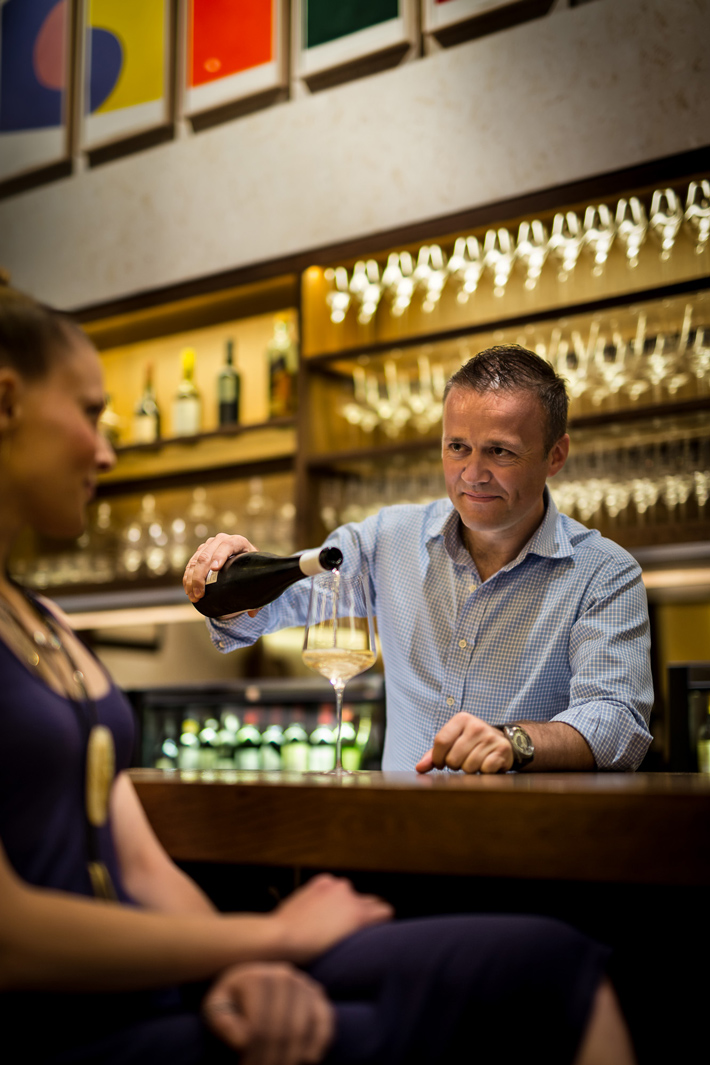 The menu is
all small plate offerings, along with 40 wines by
the glass (sensibly priced at $8-$90—this last for
Château d’Yquem Sauternes 2003) and 200 by the
bottle. Early in the evening Mr. Sohm pours wines,
before changing into a suit and darting across the
way to become the sommelier at Le Bernardin. And
what he pours the wines into are
as amazing as the wines themselves—stemware so
thin and light, I at first thought they were
plastic. On
the contrary,
they are very expensive glasses made
specially for the wine bar and are said to be
exceptionally strong rather than woefully fragile.
The menu is
all small plate offerings, along with 40 wines by
the glass (sensibly priced at $8-$90—this last for
Château d’Yquem Sauternes 2003) and 200 by the
bottle. Early in the evening Mr. Sohm pours wines,
before changing into a suit and darting across the
way to become the sommelier at Le Bernardin. And
what he pours the wines into are
as amazing as the wines themselves—stemware so
thin and light, I at first thought they were
plastic. On
the contrary,
they are very expensive glasses made
specially for the wine bar and are said to be
exceptionally strong rather than woefully fragile.
The menu isn’t long, but,
although the charcuterie is excellent and varied,
the rest of the offerings would be rare to find in
a wine bar outside of Paris: silky, seared foie
gras on a stick set on Spanish tomato-soaked
bread; potted duck rillette; roasted carrots spiced
with harissa
and pooled in a minted chicken broth; cauliflower
cooked in chicken fat, with a crisp chicken skin
crumbled on top; truffled pasta with grated
Himalayan yak cheese; and shortribs with onions
and wine reduction on richly buttered mashed
potatoes; and an irresistible warm goat’s cheese
potato parfait with arugula.
There is also a tasting section
for up to eight people.
Aldo
Sohm Wine Bar really does add a new dimension to
the genre in NYC and will probably be copied by
others before long. It is not just all about the
wine—it is about good food, comfort, and
civilized conversation.
Aldo Sohm Wine Bar is open
Mon.-Fri. for lunch and dinner; Sat. for dinner.
Charcuterie $6.50-$12; small plates $4-$12;
THE SHOP AT ANDAZ FIFTH AVENUE
212-601-1234
Although
more
of a traditional restaurant than Aldo Sohm Wine
Bar, The Shop, located just across from the NY
Public Library, is about the same size and has
something of the same ambiance, via a strong use
of wood panels, overhead lighting, sofas, and
strong colors.
And it does seem like a place to come by
before theater or for a light meal on the run or
if you’re staying in the hotel upstairs.
But I would encourage you to
linger and have a full dinner at The Shop, because
executive chef Michael Santoro, previously of The
Mildred in Philadelphia and Blue Duck Tavern in DC
and trained at fine kitchens like The Fat Duck
outside of London, Mugaritz in Spain, and Gilt in
NYC, brings a very rigorous technique to modern
American fare with a highly seasonal flair. And the
food is backed up by an attractive, young staff
that greets and treats you very well. (There’s
also a retail food shop on the premises.)
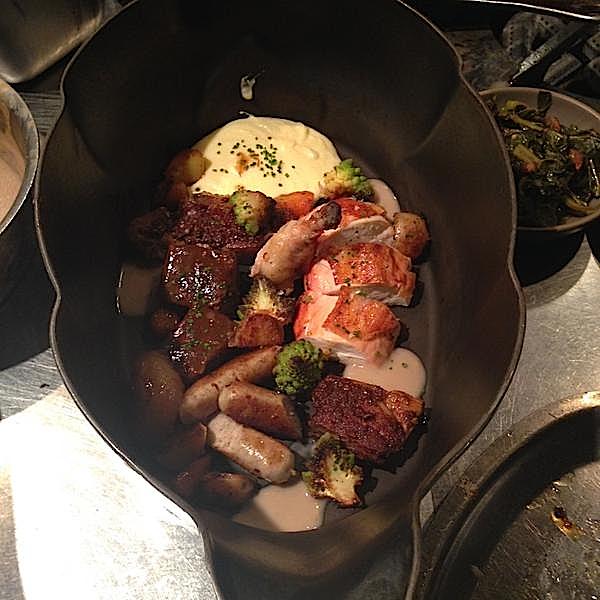 There
are small plate offerings here, too ($9-$20),
including organic heirloom tomatoes, burrata, vinegar,
and opal basil blossoms. Good grilled country bread
comes with Purple Haze goat’s cheese, stone fruit,
crushed hazelnuts and a dash of balsamic.
There
are small plate offerings here, too ($9-$20),
including organic heirloom tomatoes, burrata, vinegar,
and opal basil blossoms. Good grilled country bread
comes with Purple Haze goat’s cheese, stone fruit,
crushed hazelnuts and a dash of balsamic.
Large plates
range from "peaches and cream" sweet corn risotto,
Pernod, tarragon and mascarpone ($23) to a
terrific crispy pig’s ear salad. Spaghetti cacio e pepe—pure
Roman comfort food—is so simple that it is
extremely easy to screw up, but Mr. Santoro’s is
textbook perfect, not soupy, not dry, impeccably
al dente with just enough cheese and black pepper
to give it zing.
There’s also a delicious, crispy chicken schnitzel
with greens and a tangy dash of lemon ($25), and a
very generous casserole of short ribs (left) with
sweet polenta and baby onions that snuggled up to
roast chicken and sausages.
There are better known
restaurants in NYC—though few in midtown—doing
this kind of food as well as Mr. Santoro, but it
really shows when the chef is doing the kind of
menu on which just about everything is so
tempting. Small,
focused, intensely flavorful, his cuisine aims at
pleasure, not show-off dishes. And,
with most main courses costing $22-$28 (with three
in the mid-$30s range), The Shop is worth more
than a casual visit.
NOTES FROM THE WINE CELLAR
By John Mariani
I’m asked often enough what wines I’d want to
have if stranded on a desert island--which are the
same wines I'd love to serve for Christmas and New
Year's dinners. I always have my answer ready: Just my
favorites. I don’t want trophy wines or antiques. I
want wines I can thoroughly enjoy right now and for
several years to come. I want them to go well with
food. With
those parameters in mind, here’s my dream list of
six wonderful wines to be stranded with from
appetizers through dessert.
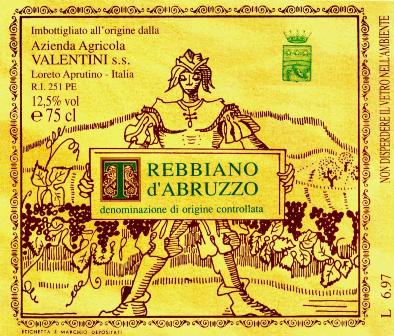 Edoardo Valentini Trebbiano
d’Abruzzo—Trebbiano is a workhorse grape in
Italy and not much in favor these days. But
that’s because only a rare, even eccentric,
winemaker like Valentini knows how to produce a
great wine from this over-planted varietal. I
remember the first time I tasted his Trebbiano
d’Abruzzo, at a seafood restaurant on the Adriatic.
The waiter brought a ten-year-old vintage I tried to
refuse. But he insisted, and I was astonished how
this usually negligible white varietal had such
marvelous fruit and acid in perfect tandem. It just
exploded in my mouth. And age—usually the killer for
Italian whites—had given it complexity and
character. With
fish it is a nonpareil white wine. A vintage like
2007 should cost about $90-$100.
Edoardo Valentini Trebbiano
d’Abruzzo—Trebbiano is a workhorse grape in
Italy and not much in favor these days. But
that’s because only a rare, even eccentric,
winemaker like Valentini knows how to produce a
great wine from this over-planted varietal. I
remember the first time I tasted his Trebbiano
d’Abruzzo, at a seafood restaurant on the Adriatic.
The waiter brought a ten-year-old vintage I tried to
refuse. But he insisted, and I was astonished how
this usually negligible white varietal had such
marvelous fruit and acid in perfect tandem. It just
exploded in my mouth. And age—usually the killer for
Italian whites—had given it complexity and
character. With
fish it is a nonpareil white wine. A vintage like
2007 should cost about $90-$100.
La Tâche—If
choosing a pricey red Burgundy, why not the more
prestigious Romanée-Conti? Sentiment, 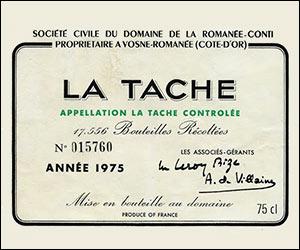 perhaps. Years and years
ago I grew to prefer La Tâche, a Grand Cru owned by
the same Domaine de la Romanée-Conti that owns
Romanée-Conti, as well as Richebourg and Romanée-St.
Vivant. Any
of these will do nicely, but for me La Tâche has
more of the taste of what I like about Vosne-Romanée
vineyards—a silkiness of texture, a refinement of
tannins and fruit, and enormous finesse at every
point on the palate. The 1990 is drinking
beautifully now and will for years to come. Expect
to pay at least $4,500 for a bottle.
perhaps. Years and years
ago I grew to prefer La Tâche, a Grand Cru owned by
the same Domaine de la Romanée-Conti that owns
Romanée-Conti, as well as Richebourg and Romanée-St.
Vivant. Any
of these will do nicely, but for me La Tâche has
more of the taste of what I like about Vosne-Romanée
vineyards—a silkiness of texture, a refinement of
tannins and fruit, and enormous finesse at every
point on the palate. The 1990 is drinking
beautifully now and will for years to come. Expect
to pay at least $4,500 for a bottle.
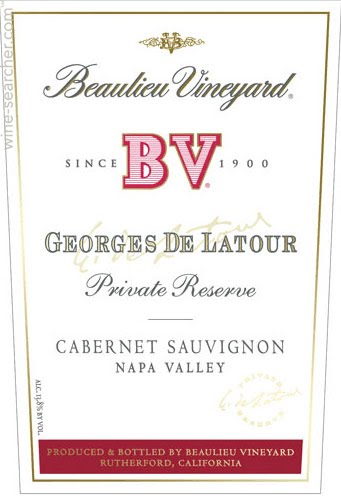 BV
Georges de la Tour Private Reserve—If
only more California wineries emulate this glorious
red wine from Beaulieu Vineyard, founded by
Frenchman George de la Tour in 1900! It has
long set the standard by which to judge the
character of the finest cabernet sauvignons of any
region in the world. It is always big but never
massive, full of California sun but never grapey,
complex throughout with a long, walnut-and-dried
cherry finish. And it is always in balance and,
unlike so many Napa Valley cabs, it can go on
forever. I’ll take a case of 1982. Much to my
amazement, prices for BV, even for the 1982 and
wines of the 1990s, stay steady at about $80-$100.
BV
Georges de la Tour Private Reserve—If
only more California wineries emulate this glorious
red wine from Beaulieu Vineyard, founded by
Frenchman George de la Tour in 1900! It has
long set the standard by which to judge the
character of the finest cabernet sauvignons of any
region in the world. It is always big but never
massive, full of California sun but never grapey,
complex throughout with a long, walnut-and-dried
cherry finish. And it is always in balance and,
unlike so many Napa Valley cabs, it can go on
forever. I’ll take a case of 1982. Much to my
amazement, prices for BV, even for the 1982 and
wines of the 1990s, stay steady at about $80-$100.
Warre's
Vintage
Port—To me Port is dessert,
although I think it’s also the best cheese wine in
the world. Attempts
by 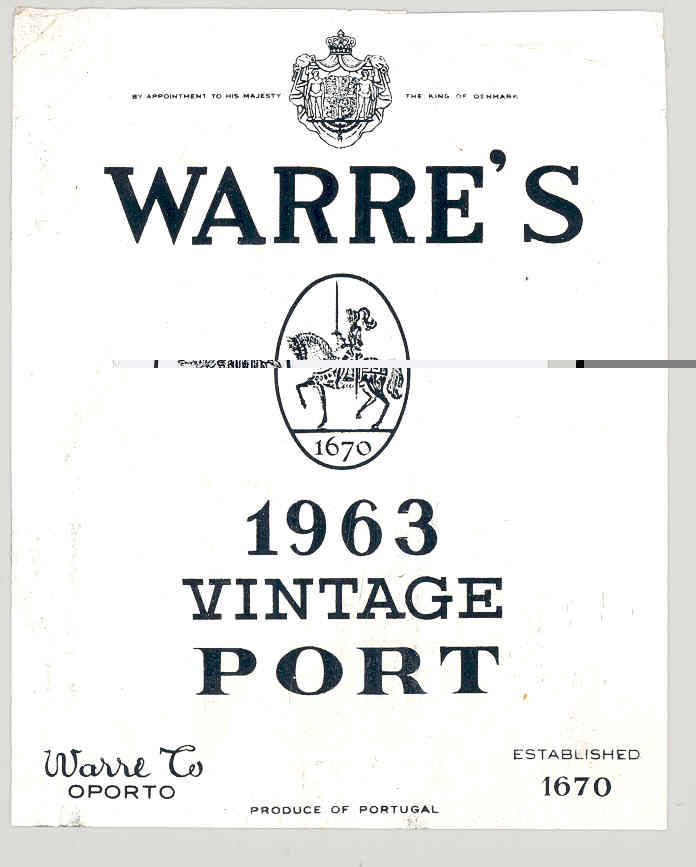 other countries at capturing the
beauty, richness, nutty sweetness, and magnificence
of a vintage Port have been futile. They lack
the depth and fineness of the Portuguese original
from the Douro River vineyards. I’ll gladly drink a
Tawny or even a lightweight Ruby any evening, but if
I want to settle in for the night, an old Vintage
from Warre's, say 1955 or 1977, would be all I could
ask for. Anything younger wouldn’t be ready or
right. The ’77 might still be found for about
$90-$100.
other countries at capturing the
beauty, richness, nutty sweetness, and magnificence
of a vintage Port have been futile. They lack
the depth and fineness of the Portuguese original
from the Douro River vineyards. I’ll gladly drink a
Tawny or even a lightweight Ruby any evening, but if
I want to settle in for the night, an old Vintage
from Warre's, say 1955 or 1977, would be all I could
ask for. Anything younger wouldn’t be ready or
right. The ’77 might still be found for about
$90-$100.
 AND THE LORD SAID UNTO HIS PEOPLE,
AND THE LORD SAID UNTO HIS PEOPLE,
"YOU WANT FRIES WITH THAT?"
A New Jersey group calling itself the "McMass Project"
has launched a fund-raising campaign to help open a
McDonald's
franchise inside a church, in order to help
"revitalize churches as centers for conversation and
cultural engagement." One of the group's founders, Paul Di é,
contended it is a valid response to the fact that
"Christianity is unable to
capture modern audiences. McDonald's
restaurants serve 70 million people each day." Di Lucca also admitted to NBC
that "we are aware a lot of people will think this
is an insane idea."

A SHORT
ARTICLE ON MEZCAL
“A very
long time ago, when I was hustling tarot-card
readings before a Grateful Dead show in Saratoga
Springs, N.Y., one of my patrons — a big, bearded
biker — handed me a wad of crumpled dollar bills and
a map. `If you’re going to the next show in
Rochester,' he said, `you can camp at this guy’s
house.' The next afternoon, my friend and I
arrived at the house, pulled our backpacks out of
the trunk of the car and rang the doorbell. The guy
in Rochester, it turned out, had no idea that some
biker at a Dead show in Saratoga had been handing
out maps to his house. But sure, he said, we could
pitch our tent. He made us coffee. More strangers —
all with the same map — filed in throughout the
afternoon. By evening, a small shantytown had
materialized in his backyard.”—Rosie Schaap, “Holy
Smoke,” NY
Times (Dec. 14, 2014)
Reliable Old Friends
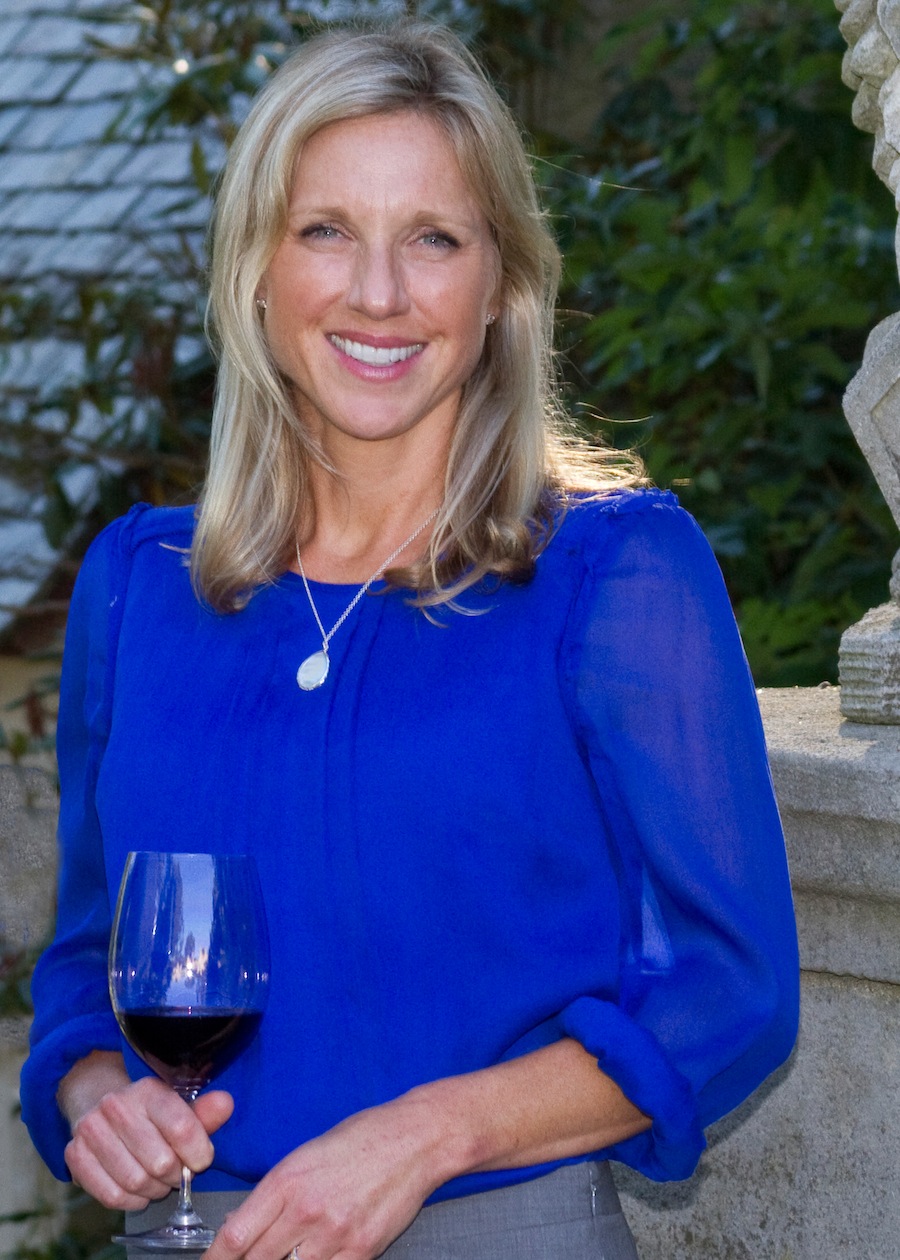
by Cristina Mariani-May
co-CEO of Banfi
Vintners America's leading wine importer
Earlier
this month I dedicated this entire space to the top ten
reasons to enjoy Rosa Regale for the holiday season. But if man
must live on more than bread alone, there is plenty of
room for other wines this time of year.
Fizz the Season – no other time of year lends itself to
bubbly more than this.
In Italy, which long ago mastered the art of
comforting hospitality, Prosecco is the ultimate hospitalian
wine. Many
restaurants offer a glass of Prosecco to arriving
guests. I
like to point out that prosecco is like Champagne in
that it is named for the unique part of the world it
hails from and has bubbles, but most of the time the
similarities end there.
Prosecco is not typically complex, austere or the
drink of millionaires; it is the light-hearted bourgeois
bubbly, to borrow a French term.
Maschio is one of
the leading producers of Prosecco. They offer
two types on the US market: Maschio Brut:
a straightforwardly dry, crisp, clean wine that is very
reasonably priced and also available in 187ml “stocking
stuffer” sizes. But
Maschio’s masterpiece is Maschio dei
Cavalieri, or the knights/cavaliers/gentlemenly
Prosecco. It
is the ne plus
ultra of prosecco – a Superiore from
the heartland Valdobiaddene
and within that from the 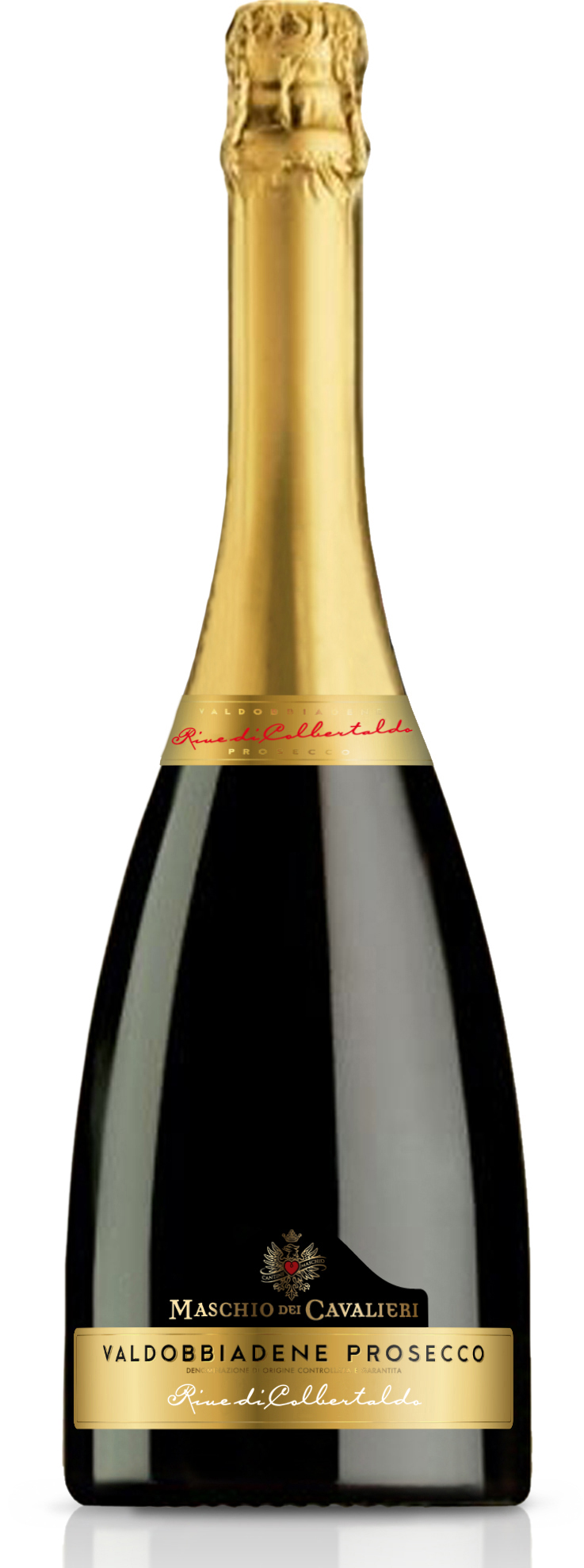 prestigious Rive di Colbertaldo
subzone. A
smooth and silky bubbly that just exudes elegance. And is still
a bargain!
prestigious Rive di Colbertaldo
subzone. A
smooth and silky bubbly that just exudes elegance. And is still
a bargain!
If you are a Champagne lover, then
consider what Italy can do with wine fermented in the
bottle as our French cousins do. Banfi Brut is a
blend of the classic champenoise
grapes – Pinot Noir, Chardonnay and Pinot Blanc,
fermented in the bottle with some additional bottle
aging before release.
It yields the yeasty, toasty flavors of its
French counterpart.
Prefer a little color? Consider Cuvee Aurora Rose,
a 100% Pinot Noir that takes its blush from brief
contact with the grape skins during fermentation (don’t
we all blush from a little skin contact?). It is pale pink and subtle, dry and
round.
Want to keep even closer to Italian traditions in
sparkling wine? Then try some dry Lambrusco. I can suggest
two to start, depending on your mood.
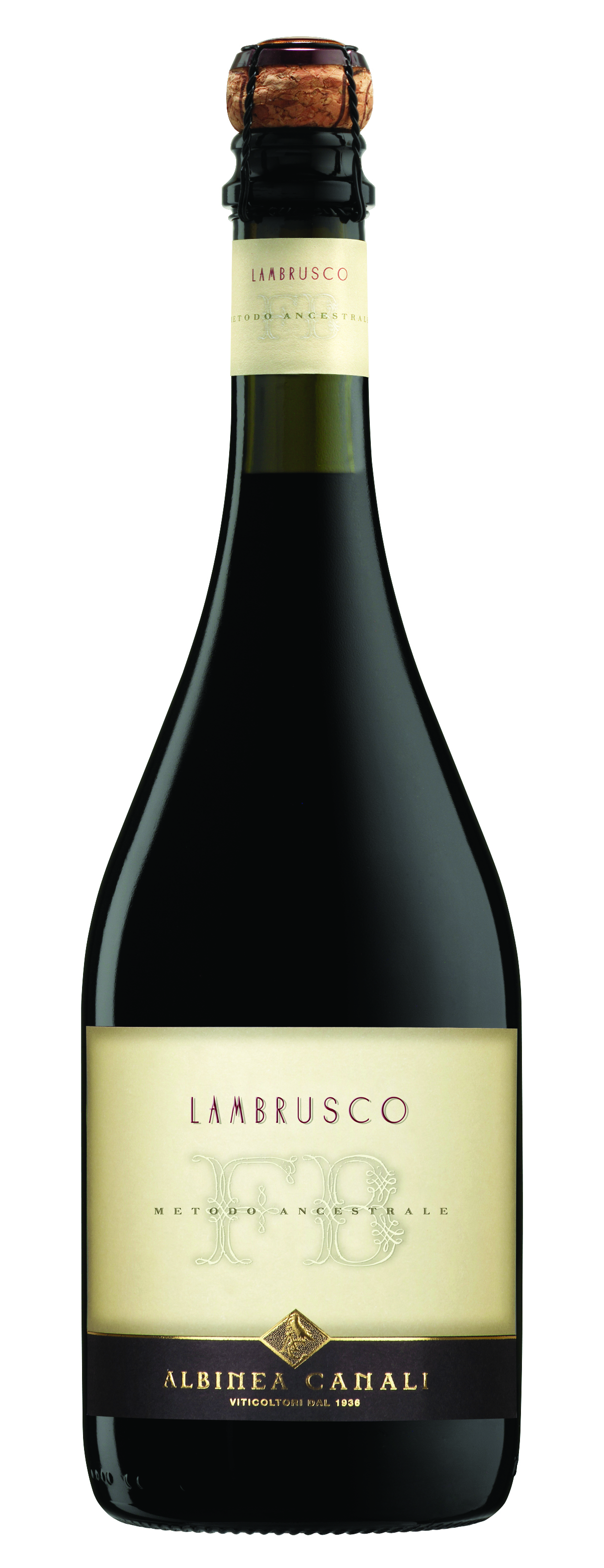 Feeling dark,
moody and deep? Try some OttocentoNero from
Albinea Canali. This opaque,
bone dry, austere Lambrusco will not only help you
ponder the true meaning of the season, but cut through
rich holiday foods like a laser.
Feeling dark,
moody and deep? Try some OttocentoNero from
Albinea Canali. This opaque,
bone dry, austere Lambrusco will not only help you
ponder the true meaning of the season, but cut through
rich holiday foods like a laser.
Feeling bright and perky? Then
opt for FB
Lambrusco, which creatively stands for ”Fermented
in the Bottle.” This is made
from the Sorbara varietal of Lambrusco, which has low
color and high acid, making it a bright light. While it is,
as the name more than subtly suggests, fermented in the
bottle, the sediment is not removed – making it less
like Champagne and more like a Weiss Bier. Each glass
will be slightly cloudier than the last but more
intensely flavored.
This is a nod to the “Metodo Ancestrale” or ancestral method
that the farmers used to make their wines – bottled in
the cool of early winter when some natural sugars remain
in the wine, only to ferment fully dry as spring
temperatures warmed the cellar and re-started
fermentation. The
ultimate Vino
Naturale!!!
Whatever form of bubbles you choose, my family and I
wish you the most sparkling of holidays!
JUST IN TIME
FOR CHRISTMAS!

I'm proud and happy to announce that my new book, The Hound in Heaven
(21st Century Lion Books), has just been published
through Amazon and Kindle. It is a Christmas
novella, and for anyone who loves dogs, Christmas,
romance, inspiration, even the supernatural, I hope
you'll find this to be a treasured favorite.
The story concerns how, after a New England teacher,
his wife and their two daughters adopt a stray puppy
found in their barn in northern Maine, their lives
seem full of promise. But when tragedy strikes,
their wonderful dog Lazarus and the spirit of
Christmas are the only things that may bring back
his master back from the edge of despair.
WATCH
THE VIDEO
“What a huge surprise turn this story took! I was
completely stunned! I truly enjoyed this book and its
message.” – Actress Ali MacGraw
“He had me at Page One. The amount of heart, human
insight, soul searching, and deft literary strength that
John Mariani pours into this airtight novella is
vertigo-inducing. Perhaps ‘wow’ would be the best
comment.” – James Dalessandro, author of Bohemian Heart
and 1906.
“John Mariani’s Hound
in Heaven starts with a well-painted portrayal
of an American family, along with the requisite dog. A
surprise event flips the action of the novel and
captures us for a voyage leading to a hopeful and
heart-warming message. A page turning, one sitting read,
it’s the perfect antidote for the winter and promotion
of holiday celebration.” – Ann Pearlman, author of The Christmas Cookie Club
and A Gift for my
Sister.
“John Mariani’s concise, achingly beautiful novella
pulls a literary rabbit out of a hat – a mash-up of the
cosmic and the intimate, the tragic and the
heart-warming – a Christmas tale for all ages, and all
faiths. Read it to your children, read it to yourself…
but read it. Early and often. Highly recommended.” – Jay
Bonansinga, New York
Times bestselling author of Pinkerton’s War, The
Sinking of The Eastland, and The Walking Dead: The Road
To Woodbury.
“Amazing things happen when you open your heart to an
animal. The Hound in
Heaven delivers a powerful story of healing
that is forged in the spiritual relationship between a
man and his best friend. The book brings a message of
hope that can enrich our images of family, love, and
loss.” – Dr. Barbara Royal, author of The Royal Treatment.
Any of John Mariani's
books below may be ordered from amazon.com.
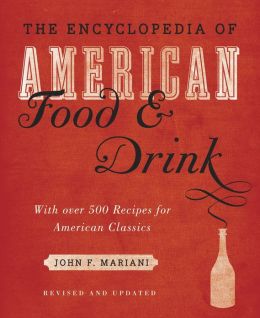 |
The Encyclopedia of American Food and Drink by John F. Mariani (Bloomsbury USA, $35) Modesty forbids me to praise my own new book, but let me proudly say that it is an extensive revision of the 4th edition that appeared more than a decade ago, before locavores, molecular cuisine, modernist cuisine, the Food Network and so much more, now included. Word origins have been completely updated, as have per capita consumption and production stats. Most important, for the first time since publication in the 1980s, the book includes more than 100 biographies of Americans who have changed the way we cook, eat and drink -- from Fannie Farmer and Julia Child to Robert Mondavi and Thomas Keller. "This book is amazing! It has entries for everything from `abalone' to `zwieback,' plus more than 500 recipes for classic American dishes and drinks."--Devra First, The Boston Globe. "Much needed in any kitchen library."--Bon Appetit. |
"Eating Italian will never be the same after reading John Mariani's entertaining and savory gastronomical history of the cuisine of Italy and how it won over appetites worldwide. . . . This book is such a tasteful narrative that it will literally make you hungry for Italian food and arouse your appetite for gastronomical history."--Don Oldenburg, USA Today. "Italian
restaurants--some good, some glitzy--far
outnumber their French rivals. Many of
these establishments are zestfully described
in How Italian Food Conquered the World, an
entertaining and fact-filled chronicle by
food-and-wine correspondent John F.
Mariani."--Aram Bakshian Jr., Wall Street
Journal.
"Equal parts
history, sociology, gastronomy, and just
plain fun, How Italian Food Conquered the
World tells the captivating and delicious
story of the (let's face it) everybody's
favorite cuisine with clarity, verve and
more than one surprise."--Colman Andrews,
editorial director of The Daily
Meal.com. "A fantastic and fascinating
read, covering everything from the influence
of Venice's spice trade to the impact of
Italian immigrants in America and the
evolution of alta cucina. This book will
serve as a terrific resource to anyone
interested in the real story of Italian
food."--Mary Ann Esposito, host of PBS-TV's
Ciao
Italia. "John Mariani has written the
definitive history of how Italians won their
way into our hearts, minds, and
stomachs. It's a story of pleasure over
pomp and taste over technique."--Danny Meyer,
owner of NYC restaurants Union Square
Cafe, The Modern, and Maialino.
|
 |
 |
 |
 |
 |
 |
 |
 |
 Everett Potter's Travel Report:
Everett Potter's Travel Report: 
 Eating Las Vegas
is the new on-line site for Virtual Gourmet
contributor John A. Curtas., who since 1995
has been commenting on the Las Vegas food
scene and reviewing restaurants for Nevada
Public Radio. He is also the
restaurant critic for KLAS TV, Channel 8 in
Las Vegas, and his past reviews can be
accessed at KNPR.org.
Click on the logo below to go directly to
his site.
Eating Las Vegas
is the new on-line site for Virtual Gourmet
contributor John A. Curtas., who since 1995
has been commenting on the Las Vegas food
scene and reviewing restaurants for Nevada
Public Radio. He is also the
restaurant critic for KLAS TV, Channel 8 in
Las Vegas, and his past reviews can be
accessed at KNPR.org.
Click on the logo below to go directly to
his site.

Tennis Resorts Online: A Critical Guide to the World's Best Tennis Resorts and Tennis Camps, published by ROGER COX, who has spent more than two decades writing about tennis travel, including a 17-year stretch for Tennis magazine. He has also written for Arthur Frommer's Budget Travel, New York Magazine, Travel & Leisure, Esquire, Money, USTA Magazine, Men's Journal, and The Robb Report. He has authored two books-The World's Best Tennis Vacations (Stephen Greene Press/Viking Penguin, 1990) and The Best Places to Stay in the Rockies (Houghton Mifflin, 1992 & 1994), and the Melbourne (Australia) chapter to the Wall Street Journal Business Guide to Cities of the Pacific Rim (Fodor's Travel Guides, 1991).


MARIANI'S VIRTUAL GOURMET
NEWSLETTER is published weekly. Editor/Publisher: John
Mariani.
Editor: Walter Bagley. Contributing Writers: Christopher Mariani,
Robert Mariani, Misha
Mariani,
John A. Curtas, Edward Brivio, Mort Hochstein,
Andrew Chalk, Dotty Griffith and Brian Freedman. Contributing
Photographers: Galina Dargery, Bobby
Pirillo. Technical Advisor: Gerry McLoughlin.
To un-subscribe from this newsletter,click here.
© copyright John Mariani 2014

